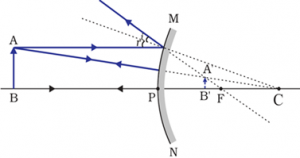Concave and Convex Mirrors
Let us know about convex mirrors and concave mirrors. Mirror is a surface which reflects a clear image. Images can be of two types: Real image and Virtual image. An image which can be formed on the screen is known as real image and the one which cannot be formed on screen is known as virtual image. These images are formed when light falls on a mirror from the object and is reflected back by the mirror on the screen. There can be two types of mirror: Curved mirror and plane mirror. If curved mirror is a part of sphere then it is known as spherical mirror. The image formed by a plane mirror is always a virtual image as it cannot be obtained on a screen. Image formed by spherical mirror can be either real or virtual. Spherical mirrors are of two types:
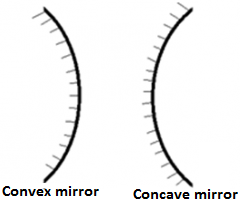
Concave Mirror: For understanding the concept of the mirror, we should know about the law of reflection which states that when a beam of light is passed through a surface then it is deflected at some angle. This angle is the angle of reflection while the incoming angle is the angle of incidence. Both are equal. A beam of light which passes through the space is invisible. It can be seen only when it hits something through which it is scattered. Light is not scattered by mirrors.
Curved mirrors can reflect the light due to their curved surface while the plane mirrors cannot. The flat mirror makes virtual image while the curved mirror forms real images. The curved mirrors are classified in two types that are concave and convex. The convex reflects at an angle at edges and also forms a smaller distorted image than actual size while the concave are converging mirror which are similar to spoon shape. These types of mirrors form image when light is bounced by their curve up to a specific area.
Convex Mirror: The mirror is defined as an optical device which has the capacity to reflect beam of light and form a clear identical image. Some beams are filtered through mirrors while some are reflected from it. But they preserve only colour or diffused light. Mirrors are used for decoration, to see our clear image, for scientific purpose, in apparatus like cameras, telescope, machines etc. generally mirrors are made up for visible light. Some common types of mirrors are flat surface mirrors and curved surface mirrors.
The plane mirrors are flat surface mirrors while the curved surface mirrors are produced a clear image with focusing of light. The spherical mirrors are of two types that are concave and convex mirrors. These are used because of their one of the main advantage that they form an image without chromatic aberration.
Image formation by Concave and Convex Mirrors:
Ray Diagram for Concave Mirrors:
- When an object is placed at infinity, a real image is formed at the focus. The size of the image is much smaller as compared to that of the object.
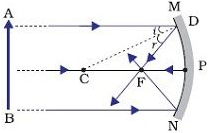
- When an object is placed behind the centre of curvature, a real image is formed between the centre of curvature and focus. The size of the image is smaller as compares to that of the object.
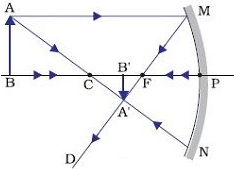
- When an object is placed at the centre of curvature and focus, the real image is formed at the centre of curvature. The size of the image is same as compared to that of the object.
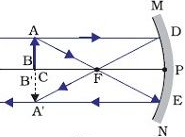
- When an object is placed in between the centre of curvature and focus, the real image is formed behind the centre of curvature. The size of the image is smaller as compared to that of the object.

- When an object is placed at the focus, the real image is formed at infinity. The size of the image is much larger as compared to that of the object.
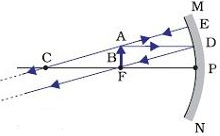
- When an object is placed in between focus and pole, a virtual image is formed. The size of the image is larger as compared to that of the object.
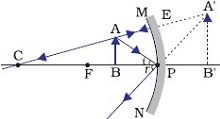
Ray Diagrams for Convex Mirrors:
- When an object is placed at infinity, a virtual image is formed at the focus. The size of the images is much smaller as compared to that of the object.
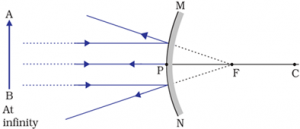
- When an object is placed at a finite distance from the mirror, a virtual image is formed between pole and focus of the convex mirror. The size of the image is smaller as compared to that of the object.
